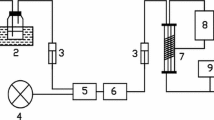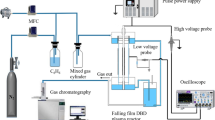Abstract
Ultraviolet (UV) light with a wavelength of 254 nm was applied to a double dielectric barrier discharge (DDBD) system to decompose of gaseous xylene. The results show that a significantly synergistic effect can be achieved with the introduction of UV light into the DDBD system. When UV light is applied, the system show a 21.8 % increase in its removal efficiency for xylene at 35 kV with an ozone concentration close to 971 ppmv. The CO x (x = CO2 and CO) selectivity of outlet gas rises from 6.54 to 76.2 %. The optimal synergetic effect between UV light and DDBD can be obtained at a peak voltage of 30 kV. The system is robust for humidity, which only slightly reduces the xylene removal efficiency at a high peak voltage (30–35 kV). With the increase of gas flow rate, the removal efficiency for xylene decreases due to a reduced residence time. In addition, the products of xylene degradation were also analyzed. The major products of the degradation were found to be CO2 and H2O while byproducts such as O3 and HCOOH were observed as well.









Similar content being viewed by others
References
Duane M, Poma B, Rembges D, Astorga C, Larsen BR (2002) Isoprene and its degradation products as strong ozone precursors in Insubria, Northern Italy. Atmos Environ 36:3867–3879
Sultana S, Vandenbroucke AM, Leys C, De Geyter N, Morent R (2015) Abatement of VOCs with alternate adsorption and plasma-assisted regeneration: a review. Catalysts 5:718–746
Kogelschatz U (2003) Dielectric-barrier discharges: their history, discharge physics, and industrial applications. Plasma Chem Plasma Process 23:1–46
Chae JO, Moon SI, Sun HS, Kim KY, Vassiliev VA, Mikholap EM (1999) A study of volatile organic compounds decomposition with the use of non-thermal plasma. KSME Int J 13:647–655
Zhang HB, Li K, Shu CH, Lou ZY, Sun TH, Jia JP (2014) Enhancement of styrene removal using a novel double-tube dielectric barrier discharge (DDBD) reactor. Chem Eng J 256:107–118
Ye ZL, Shen Y, Zhang RX, Hou HQ (2008) Destruction of benzene in an air stream by the outer combined plasma photolysis method. J Phys D Appl Phys 41:025201
Assadi AA, Bouzaza A, Merabet S, Wolbert D (2014) Modeling and simulation of VOCs removal by nonthermal plasma discharge with photocatalysis in a continuous reactor: synergetic effect and mass transfer. Chem Eng J 258:119–127
Palau J, Assadi AA, Penya-Roja JM, Bouzaza A, Wolbert D, Martinez-Soria V (2015) Isovaleraldehyde degradation using UV photocatalytic and dielectric barrier discharge reactors, and their combinations. J Photochem Photobiol A 299:110–117
Zhang HB, Li K, Sun TH, Jia JP, Lou ZY, Yao SA, Wang G (2015) The combination effect of dielectric barrier discharge (DBD) and TiO2 catalytic process on styrene removal and the analysis of the by-products and intermediates. Res Chem Intermed 41:175–189
Chang MB, Balbach JH, Rood MJ, Kushner MJ (1991) Removal of SO2 from gas streams using a dielectric barrier discharge and combined plasma photolysis. J Appl Phys 69:4409–4417
Chang MB, Kushner MJ, Rood MJ (1993) Removal of SO2 and no from gas streams with combined plasma photolysis. J Environ Eng ASCE 119:414–423
Fang HH, Hou HQ, Xia LY, Shu XH, Zhang RX (2007) A combined plasma photolysis (CPP) method for removal Of CS2 from gas streams at atmospheric pressure. Chemosphere 69:1734–1739
Huang L, Xia LY, Ge XX, Jing HY, Dong WB, Hou HG (2012) Removal of H2S from gas stream using combined plasma photolysis technique at atmospheric pressure. Chemosphere 88:229–234
Zhang H, Ji TY, Zhang RX, Hou HQ (2012) Destruction of H2S gas with a combined plasma photolysis (CPP) reactor. Plasma Sci Technol 14:134–139
Robert P, Sung KJ, Chul A, Soon YY, Demidyuk V (2006) Experimental study of toluene decomposition by combination of barrier discharge plasma and UV light. WIT Trans Ecol Environ 86:401–410 (J. W. S. Longhurst and C. A. Brebbia)
Zhu CZ, Liu Y, Lu J, Yang Z, Li YX, Chen TH (2015) Decomposition of ethanethiol using dielectric barrier discharge combined with 185 nm UV-light technique. Plasma Chem Plasma Process 35:355–364
Lee HM, Chang MB (2003) Abatement of gas-phase p-xylene via dielectric barrier discharges. Plasma Chem Plasma Process 23:541–558
Ruan JJ, Li W, Shi Y, Nie Y, Wang X, Tan TE (2005) Decomposition of simulated odors in municipal wastewater treatment plants by a wire-plate pulse corona reactor. Chemosphere 59:327–333
Alapi T, Dombi A (2007) Direct VUV photolysis of chlorinated methanes and their mixtures in an oxygen stream using an ozone producing low-pressure mercury vapour lamp. Chemosphere 67:693–701
Pan H, Su QF, Wei JW, Jian YF (2015) Promotion of nonthermal plasma on the SO2 and H2O tolerance of Co–In/Zeolites for the catalytic reduction of NOx by C3H8 at low temperature. Plasma Chem Plasma Process 35:831–844
Assadi AA, Bouzaza A, Vallet C, Wolbert D (2014) Use of DBD plasma, photocatalysis, and combined DBD plasma/photocatalysis in a continuous annular reactor for isovaleraldehyde elimination—synergetic effect and byproducts identification. Chem Eng J 254:124–132
Taranto R, Frochot D, Pichat P (2007) Combining cold plasma and TiO2 photocatalysis to purify gaseous effluents: a preliminary study using methanol-contaminated air. Ind Eng Chem Res 46:7611–7614
Huang HB, Ye DQ (2009) Combination of photocatalysis downstream the non-thermal plasma reactor for oxidation of gas-phase toluene. J Hazard Mater 171:535–541
Van Durme J, Dewulf J, Sysmans W, Leys C, Van Langenhove H (2007) Abatement and degradation pathways of toluene in indoor air by positive corona discharge. Chemosphere 68:1821–1829
Chen J, Yang JT, Pan H, Su QF, Liu YM, Shi Y (2010) Abatement of malodorants from pesticide factory in dielectric barrier discharges. J Hazard Mater 177:908–913
Fan X, Zhu TL, Wan YJ, Yan XA (2010) Effects of humidity on the plasma-catalytic removal of low-concentration BTX in air. J Hazard Mater 180:616–621
Assadi AA, Palau J, Bouzaza A, Penya-Roja J, Martinez-Soriac V, Wolbert D (2014) Abatement of 3-methylbutanal and trimethylamine with combined plasma and photocatalysis in a continuous planar reactor. J Photochem Photobiol A 282:1–8
Chen J, Su QF, Pan H, Wei JW, Zhang XM, Shi Y (2009) Influence of balance gas mixture on decomposition of dimethyl sulfide in a wire–cylinder pulse corona reactor. Chemosphere 75:261–265
Guo YF, Ye DQ, Chen KF, Tian YF (2006) Humidity effect on toluene decomposition in a wire-plate dielectric barrier discharge reactor. Plasma Chem Plasma Process 26:237–249
Ye ZP, Wang CX, Shao ZH, Ye Q, He Y, Shi Y (2012) A novel dielectric barrier discharge reactor with photocatalytic electrode based on sintered metal fibers for abatement of xylene. J Hazard Mater 241:216–223
Wei BL, Chen YP, Ye MJ, Shao ZH, He Y, Shi Y (2015) Enhanced degradation of gaseous xylene using surface acidized TiO2 catalyst with non-thermal plasmas. Plasma Chem Plasma Process 35:173–186
Chen JH, Wang PX (2005) Effect of relative humidity on electron distribution and ozone production by DC coronas in air. IEEE Trans Plasma Sci 33:808–812
Acknowledgments
This work was supported by the National Natural Science Foundation of China through (Grant Numbers 21450110411, 21476191, 91434110).
Author information
Authors and Affiliations
Corresponding author
Rights and permissions
About this article
Cite this article
Shi, Y., Shao, Z., Shou, T. et al. Abatement of Gaseous Xylene Using Double Dielectric Barrier Discharge Plasma with In Situ UV Light: Operating Parameters and Byproduct Analysis. Plasma Chem Plasma Process 36, 1501–1515 (2016). https://doi.org/10.1007/s11090-016-9741-2
Received:
Accepted:
Published:
Issue Date:
DOI: https://doi.org/10.1007/s11090-016-9741-2




